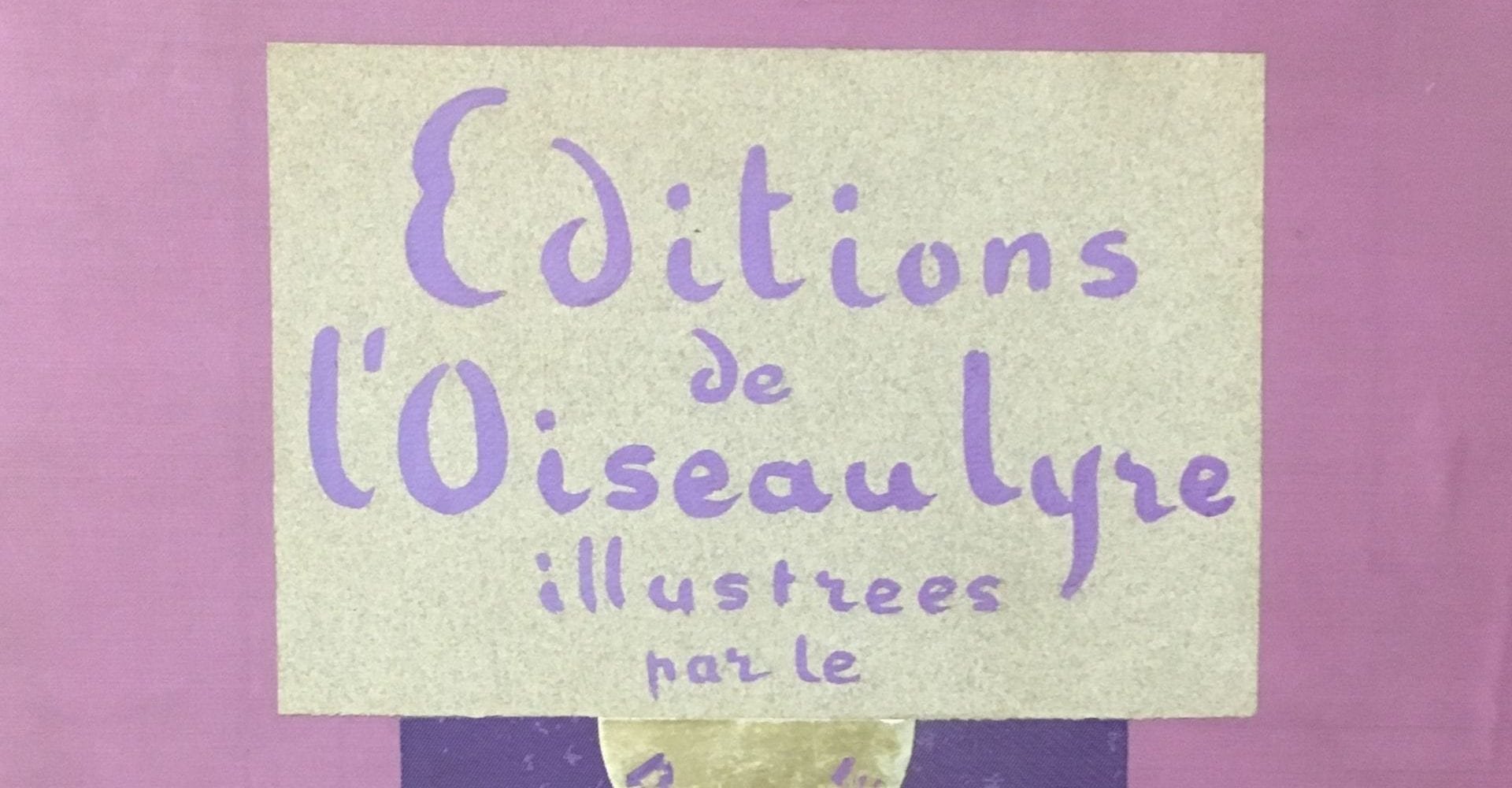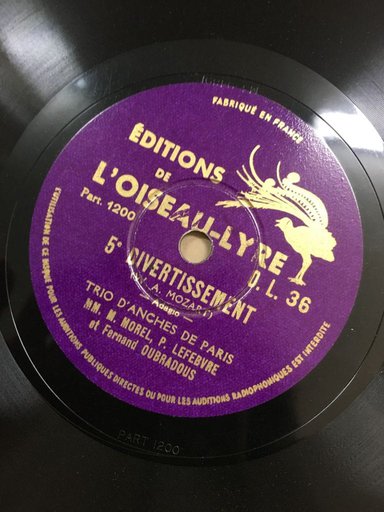Louise Hanson-Dyer and Editions de l’Oiseau-Lyre International Research Network
Sound recordings: Trio d’Anches de Paris

Within the Éditions de l’Oiseau-Lyre catalogue of 78 rpm recordings, one ensemble that features particularly prominently is the Trio d’Anches de Paris, the pioneering French reed trio comprising Fernand Oubradous (bassoon), Myrtil Morel (oboe), and Pierre Lefèbvre (clarinet). Louise Hanson-Dyer was a fierce promoter of the group in the 1930s and beyond, and the three musicians appear on Oiseau-Lyre recordings of modern works, early music with woodwind parts, and a handful of pieces from the 18th and 19th centuries. Digitised versions of the majority of these recordings have been made and are located in the Editions de l’Oiseau-Lyre archive.
The Trio commissioned a long list of contemporary works in the 1930s, documented in 'Paris Sounds' on the Archives and Special Collections website (Rare Music > Resources > Paris Sounds). In addition to these entirely new works, the group’s bassoonist, Oubradous (1903–1986), prepared many reed trio arrangements of pieces originally composed for keyboard or ensemble. The first (OL 8) was a reed trio transcription of Bach’s Prelude & Fugue in B minor, recorded in Paris in December 1937 and released on a single disc early the following year. In March 1939, the Trio recorded another of Oubradous’s Bach transcriptions: the Suite française in B minor (OL 120 & 21). Despite being made more than 80 years ago, the woodwind playing on both of these recordings still sounds remarkably fresh, and the technique of the three musicians—heard especially in the control in the French Suite’s Gavotte, and the showiness of its Minuet—makes it plain to see why they were considered the ultimate virtuosos of their day. Dyer released a set of parts to complement the Prelude & Fugue in 1938, but no printed music supplemented the latter Bach recording.
Between 1937 and 1938, Oubradous took to transcribing for reed trio the Cinq divertissements attributed to Mozart (composed c.1783–1788).

As the divertissments were originally scored for three basset horns (or two basset horns with bassoon), Oubradous’s transcriptions are aesthetically quite close to the sound of the original works, at least compared with the many keyboard or small ensemble arrangements to have appeared since they were conceived. Interestingly, Oubradous’s arrangements were not prepared in chronological order; the fourth was recorded first, and released across two separate discs (OL 15 & 16) in early 1938. Oiseau-Lyre released the Trio d’Anches’s recording of the fifth divertissement (OL 36 & 37) later the same year, and the first, second and third (OL 64 & 65; OL 66 & 67; OL 68 & 69) were recorded at the very end of 1938, ready for commercial release at the beginning of 1939. Dyer published the scores of Oubradous’s Mozart arrangements in the same order: the fourth and fifth in 1938 and 1939 respectively, and the first, second and third in 1946.
Members of the Trio d’Anches, Oubradous in particular, also made several recordings of 18th- and 19th-century music originally composed for reed instruments. (As the scores for these works were already available, the recordings are not based on Oiseau-Lyre sheet music.) The first to be produced was Beethoven’s Duo No. 2 for clarinet and bassoon (OL 4), recorded in the Trio’s initial session for Oiseau-Lyre in December 1937. As with the divertissements, Oubradous and Lefèbvre recorded the remaining Beethoven duos out of sequence: Duo Nos. 3 and 1 were released across two discs (OL 78, 79 & 80) in early 1939. Oubradous and Lefèbvre display a sense of familiarity with each other’s playing across these three discs, resulting in a performance of superior musicianship.
Mikhaïl Glinka’s Trio pathétique in D minor (OL 34 & 35) was the second non-contemporary, non-arranged work recorded by members of the Trio d’Anches de Paris. The ensuing discs, recorded and released in 1938, feature Oubradous and Lefèbvre joined by their pianist friend Noël Gallon, who appeared regularly in the 78s catalogue mostly as an accompanist to singers. Yet Gallon also appeared in the Oiseau-Lyre recording of an early Beethoven Trio (WoO 37, OL 81 & 82), performing on this occasion with bassoon and flute, rather than clarinet. Oubradous was joined on the recording by the Parisian flautist and pedagogue, Marcel Moyse.
As well as being an accomplished chamber and orchestral musician, arranger, composer and conductor, Oubradous was in demand in Paris as a soloist, particularly in the 1930s. His first feature recording for Oiseau-Lyre was of the Andante et rondo hongrois by Carl Maria von Weber (OL 14). In December 1937 when Oubradous made his recording, the Weber was the only ‘serious’ bassoon piece to have been hitherto released commercially; William Gruner, the German-born bassoonist of the Philadelphia Orchestra, had made two separate recordings in 1920 and 1926, both for the American label Victor.[1] Given this legacy, it is likely that Oubradous wanted to leave his mark—or perhaps a French mark—on the popular concert work. Oubradous was accompanied in his recording by the Orchestre de la Société des Concerts du Conservatoire and conducted by his friend Roger Désormière. Unlike the earlier Victor recordings, which were heavily cut down to fit on a single side of a 78, Dyer offered Oubradous the whole disc, meaning only a few minor cuts were made to the Rondo, and the Andante on the A-side is completely intact. Oubradous returned to Weber in 1938, when filling out a final, blank side of the first Beethoven Duo recording. The B-side of OL 80 features the slow movement of the Concerto in F Major op. 75, Weber’s only other composition for bassoon.
For woodwind soloists, there is arguably no better way to showcase one’s technical skill than to perform a Mozart concerto. This is presumably what Oubradous had intended to do for his second recording as soloist (OL 40 & 41). Across these two discs, titled Concerto No. 2 for Bassoon in B-flat Major, Oubradous performs alongside an unnamed orchestra conducted by Edvard Fendler. Curiously, it has since been argued that this ‘Concerto No. 2’ was attributed erroneously to Mozart; it is now presumed to be the work of François Devienne, a composer and Professor of Flute at the Paris Conservatoire at the end of the 18th century. Nicknamed ‘the French Mozart’, Devienne also played the bassoon, and is known to have composed at least four other concertos for the instrument. With the benefit of hindsight, the concerto Oubradous recorded is perhaps too ‘clunky’ to be a Mozart work, but it is nonetheless a pleasant, whimsical piece that showcases the abilities of the soloist effectively. A faint clicking of keys can be heard in the recording as Oubradous navigates the work’s many agile sections. The B-side of the first disc is particularly impressive, with extended semiquaver passages and an epic cadenza.
Oubradous’s final recording as soloist for Oiseau-Lyre was of a work by Joseph Bodin de Boismortier, a French Baroque composer known for publishing prolifically in the Italian concerto genre. Oubradous’s recording of the Concerto for Bassoon and Orchestra in D Major (OL 145) was made in 1948. He was again conducted by Désormière, but this time the accompaniment was provided by Dyer’s house orchestra, the Ensemble Orchestral de l’Oiseau-Lyre. The calibre of this recording was recognised nationally; in 1949 it received the prestigious Grand Prix du Disque, an award inaugurated by the Académie Charles Cros in 1948 (and which has continued into the present day).
Oubradous became better known as a conductor and pedagogue after World War II, but his career as a soloist and chamber musician in the interwar years was truly remarkable. Thanks to the technology made accessible to him by Dyer, his efforts to promote woodwind instruments and their repertoire were fortunately preserved as recorded sound, allowing them to be heard and enjoyed digitally today.
[1] https://davidawells.com/tag/fernand-oubradous.
Madeline Roycroft
Research Assistant
Editions de l’Oiseau-Lyre projects
Rare Music, Archives and Special Collections
November 28, 2021